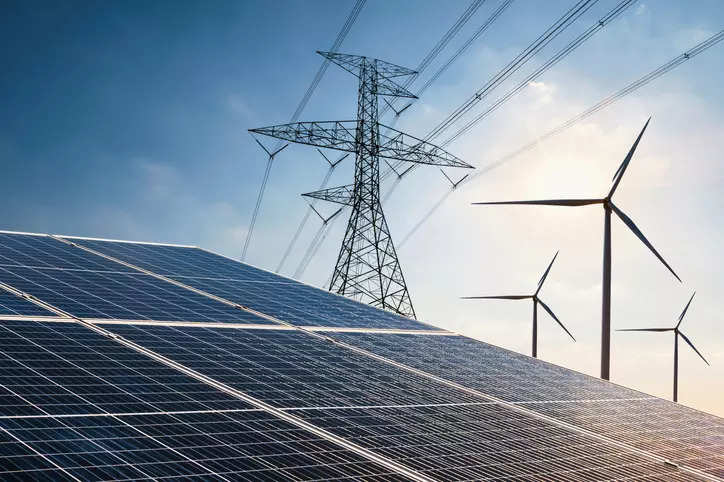Investing in renewable energy is more than just a financial decision; it’s a chance to support the planet while potentially earning returns. As concerns about climate change rise and technology advances, renewable energy has shifted from an alternative to a mainstream opportunity. For those new to the investment landscape, understanding how to navigate this sector can feel overwhelming. This guide provides a comprehensive breakdown of how to invest in renewable energy projects, from basic principles to actionable tips for creating a sustainable portfolio.
Contents
- Why Consider Renewable Energy as an Investment?
- Types of Renewable Energy Projects
- Options for Investing in Renewable Energy
- Steps to Start Investing in Renewable Energy
- Benefits and Challenges of Renewable Energy Investment
- Tax Implications and Incentives
- Evaluating Investment Risks
- Tips for First-Time Investors in Renewable Energy
- Tracking and Managing Your Renewable Energy Investments
- Emerging Trends in Renewable Energy
- Sustainable Investment and the Future of Finance
- Frequently Asked Questions (FAQs)
- Conclusion
Why Consider Renewable Energy as an Investment?
Renewable energy has unique advantages that set it apart from traditional sectors. First, there’s the environmental impact. Supporting clean energy, like solar or wind, helps to reduce carbon emissions and fosters sustainability. But beyond the ethical aspects, the financial incentives are strong, too. Governments worldwide are offering tax breaks, subsidies, and grants to encourage renewable investment, which can mean lower risk and better yields for investors. Moreover, renewable energy companies often have stable, long-term revenue due to power purchase agreements (PPAs) with utilities, creating consistent cash flow.
Types of Renewable Energy Projects

Before jumping in, it’s essential to know the types of renewable energy sources available. The four main types are:
- Solar Energy: Harnessing sunlight using photovoltaic cells or solar panels.
- Wind Energy: Utilizing wind turbines to convert wind into electricity.
- Hydropower: Generating power through water flow, typically from dams.
- Biomass and Geothermal: Biomass uses organic material for energy, while geothermal harnesses heat from the Earth.
Each type has its own financial dynamics, benefits, and potential drawbacks. Solar and wind, for instance, have high setup costs but offer long-term stability. Hydropower can be more consistent but is limited by geographical constraints. Understanding these distinctions helps in making an informed choice.
Options for Investing in Renewable Energy
Investors can access the renewable energy sector in a few different ways, each with its unique benefits and potential returns.
1. Direct Investment in Projects
Investing directly in a renewable energy project, such as a solar farm or wind plant, allows investors to own a piece of the project. This method offers the highest potential for returns, but it also comes with the most risk and requires significant upfront capital. Direct investments are typically pursued by experienced investors or institutions due to the complexity involved.
2. Stocks in Renewable Energy Companies
Publicly traded companies, like Tesla (solar), NextEra Energy (wind and solar), and Ormat Technologies (geothermal), offer an entry point into the sector. Buying stocks means purchasing shares in companies that are heavily invested in renewables. This approach is accessible, doesn’t require large amounts of money, and offers liquidity, allowing investors to buy or sell shares easily.
3. Exchange-Traded Funds (ETFs) and Mutual Funds
ETFs and mutual funds focused on renewable energy provide a diversified approach. For instance, the iShares Global Clean Energy ETF (ICLN) holds stocks of companies worldwide involved in clean energy. These funds reduce risk by spreading investment across multiple companies, making them ideal for beginner investors seeking steady growth.
4. Green Bonds
Green bonds are fixed-income investments designed to fund environmentally friendly projects. Governments, municipalities, or corporations issue these bonds to raise money for renewable energy or sustainable projects. Green bonds offer a lower risk profile but generally come with lower returns, making them suitable for conservative investors.
Steps to Start Investing in Renewable Energy
Embarking on this journey requires a mix of research, planning, and understanding of the sector. Here are the key steps:
1. Research and Identify the Right Investment
Every successful investment starts with thorough research. Investigate various renewable sectors (solar, wind, etc.), companies, or projects and understand their profitability, risks, and market presence. Use tools like the Bloomberg Terminal, company reports, and reputable financial news sources to gather data.
2. Set Financial Goals
Establishing clear goals helps to direct the investment process. Are you aiming for short-term profits or long-term growth? A stable income stream or capital appreciation? Knowing this clarifies which type of renewable energy investment aligns best with your objectives.
3. Determine Risk Tolerance
Risk tolerance varies from one person to another. Investing in renewable energy has unique risks, including regulatory changes, technological advances, and fluctuating energy prices. For beginners, ETFs and green bonds offer a safer start. Higher-risk investors might explore direct project investments or individual stocks.
4. Select a Reputable Platform or Broker
Online brokerage platforms like Vanguard, Fidelity, and eToro offer a wide range of renewable energy stocks, ETFs, and green bonds. Ensure the platform is secure, offers a user-friendly experience, and provides access to research tools. Some platforms cater to socially responsible investing (SRI), making it easier to filter for renewable-focused investments.
Benefits and Challenges of Renewable Energy Investment
While investing in renewables can be rewarding, it’s very important to weigh both the benefits and challenges before diving in.
Benefits of Investing in Renewable Energy
- Environmental Impact: Contributes positively to reducing carbon emissions.
- Growing Market: The renewable sector is expanding, with an increasing number of companies and projects.
- Government Incentives: Tax breaks, grants, and incentives enhance investment value.
- Diversification: Adding renewables diversifies a portfolio, reducing exposure to fossil fuels.
Challenges to Consider
- Regulatory Risks: Policies can change, affecting profits and stability.
- High Initial Costs: Direct investments in projects require substantial capital.
- Market Volatility: Energy prices can fluctuate, impacting returns.
- Technological Advancements: Rapid innovation can make existing technologies obsolete, impacting investments.
Tax Implications and Incentives
One of the advantages of investing in renewables is the tax incentives often available. In many countries, investors may qualify for tax credits, deductions, or exemptions, particularly if they invest in renewable energy projects directly. The U.S., for instance, offers the Investment Tax Credit (ITC) for solar energy, reducing federal income taxes for residential and commercial installations. Additionally, grants and state-level incentives may further reduce costs, increasing the net return on investment.
Evaluating Investment Risks
While renewable energy has enormous potential, it’s not without its risks. Regulatory and policy changes can alter the landscape, impacting profitability. For instance, subsidies may reduce, or governments may change the laws surrounding renewable installations. Market risks, such as fluctuating energy prices and competition from established fossil fuels, also affect returns. Investors should stay informed about the economic and political environment influencing the sector.
Tips for First-Time Investors in Renewable Energy
- Start Small: New investors might begin with ETFs or mutual funds, providing a diversified entry.
- Stay Updated: Renewable energy is fast-evolving; staying informed on industry news is crucial.
- Consider SRI: Socially Responsible Investing (SRI) screens companies that align with ethical standards, ensuring your money supports green practices.
- Be Patient: Renewable energy often yields long-term returns; don’t expect rapid gains.
- Consult Financial Experts: Guidance from financial advisors experienced in sustainable investing can be beneficial.
Tracking and Managing Your Renewable Energy Investments
Regular monitoring of your investments is essential to stay on top of market changes and ensure alignment with financial goals. Tools like Google Finance, Morningstar, and portfolio management apps provide insights and tracking options. Rebalancing the portfolio periodically, particularly with ETFs, can optimize performance, ensuring the investments continue meeting your objectives.
Emerging Trends in Renewable Energy
The renewable energy sector is undergoing rapid innovation, with new technologies constantly emerging. Energy storage solutions, like battery technology, are advancing, making solar and wind energy more reliable by storing excess power for later use. Hydrogen energy is also gaining traction as a clean alternative, especially in industrial applications. As these technologies mature, they create fresh investment opportunities.
Sustainable Investment and the Future of Finance
Renewable energy investment goes beyond profits; it’s part of a broader trend toward sustainable finance. Investors are increasingly choosing assets that align with their values, emphasizing environmental, social, and governance (ESG) criteria. Sustainable finance, which includes renewable energy, impacts global economic trends, influencing corporate behavior and contributing to a greener planet.
Frequently Asked Questions (FAQs)
Here are answers to frequently asked questions that you might find helpful to you.
What Are the Main Types of Renewable Energy Projects I Can Invest In?
There are several main types of renewable energy projects to consider, each offering distinct benefits and risks. Solar power projects involve installing solar panels to capture sunlight and convert it to electricity. Wind energy projects use turbines to harness wind power, ideal for areas with strong, steady winds. Hydropower projects generate energy from flowing water, often requiring substantial infrastructure. Geothermal energy captures heat from the earth and can be profitable, though it’s location-dependent. Biomass and biofuel projects convert organic materials to energy, focusing on sustainable waste use. Each type has unique factors, so understanding their technologies, environmental impact, and growth potential will help narrow down the best fit.
What Is a Renewable Energy Mutual Fund, and How Does It Work?
A renewable energy mutual fund is an investment vehicle that pools money from investors to invest in stocks of companies involved in renewable energy. Managed by professionals, these funds diversify across various renewable sectors, like solar, wind, and bioenergy, to reduce risk. By investing in mutual funds, you can gain exposure to multiple renewable energy companies without directly managing each stock. It’s a convenient option if you prefer a hands-off approach and want a diversified, professionally managed investment in renewable energy.
Can Renewable Energy Investments Offer Reliable Returns for Retirement?
Yes, renewable energy investments can be a reliable part of a diversified retirement portfolio. With the global push toward sustainability, renewable energy companies and projects have shown steady growth, making them appealing for long-term investors. Green bonds, for example, offer fixed returns with lower risk, while ETFs and mutual funds provide exposure to the broader renewable sector. It’s essential to balance these with traditional investments, as renewable energy markets can be volatile. Proper diversification and choosing stable renewable sectors can make this a valuable asset in retirement planning.
How Do Tax Incentives Impact My Returns on Renewable Energy Investments?
Tax incentives can significantly improve the returns on renewable energy investments. Many governments offer tax credits, deductions, or rebates to encourage green investments. For example, in the U.S., investors in certain renewable energy projects, like solar installations, can qualify for the Investment Tax Credit (ITC), reducing their tax burden. Some regions offer accelerated depreciation benefits, allowing investors to recover costs faster. These incentives boost overall returns and make renewable projects more financially attractive, but it’s crucial to understand which incentives apply to your specific investment and location.
Is It Better to Invest in Large Corporations or Small Renewable Startups?
Investing in both large corporations and small startups in the renewable sector has its advantages and trade-offs. Large corporations tend to be more stable and have established revenue streams, making them less risky. They can handle economic downturns better and offer steady, often lower, returns. Startups, on the other hand, carry higher risk but offer significant growth potential. Innovations in solar technology or bioenergy solutions may yield higher returns if the startup succeeds. A balanced approach, combining stable corporations with promising startups, may offer the best risk-reward ratio.
How Can I Invest in Renewable Energy Without Owning Physical Assets?
You can invest in renewable energy without owning physical assets by purchasing stocks of renewable energy companies, ETFs, and green bonds. Renewable energy ETFs provide diversified exposure to various renewable sectors and companies, allowing you to benefit from the industry’s growth. Green bonds are debt instruments issued by companies to fund environmentally-friendly projects, offering fixed returns similar to traditional bonds. Mutual funds focused on renewable energy also allow indirect investments. These options let you participate in the renewable energy market without the need for substantial capital or direct asset management.
What Risks Should I Be Aware of When Investing in Renewable Energy?
Investing in renewable energy comes with several risks, including regulatory, technological, and market risks. Regulatory changes, such as policy shifts or incentive removal, can affect project profitability. Technological risks stem from rapid advancements or disruptions in renewable technology, which can impact project viability or efficiency. Market risks include fluctuations in energy prices and competition with fossil fuels, which may affect demand. Additionally, geographic risks may impact project effectiveness, especially in wind or hydropower projects. Being aware of these risks can help investors mitigate them through diversified strategies and informed decision-making.
How Do I Evaluate the Financial Health of a Renewable Energy Company?
To evaluate the financial health of a renewable energy company, examine its financial statements, focusing on revenue, profit margins, and debt levels. Look for consistent revenue growth, as it indicates demand and expansion potential. Healthy profit margins suggest efficient operations, while manageable debt levels reflect financial stability. Assess cash flow, as renewable projects often have significant upfront costs; positive cash flow indicates the company can fund operations and investments. Market position, partnerships, and project pipeline also offer insights into the company’s future growth and financial health.
What Role Does Government Policy Play in Renewable Energy Investments?
Government policy plays a critical role in shaping renewable energy investments, as policies often provide the necessary incentives, grants, and tax breaks to make these projects viable. Policies such as tax credits for solar installations or subsidies for wind farms reduce costs and improve profitability for both developers and investors. Supportive regulations can drive demand for renewable energy, increasing growth potential, while unfavorable policy changes, like removing subsidies, can negatively impact investment returns. Staying informed about policy trends is essential for renewable investors, as these decisions impact the financial viability and growth of renewable energy sectors.
Conclusion
Renewable energy investment offers a unique blend of ethical impact and financial potential. By supporting clean energy initiatives, investors contribute to environmental protection and participate in a growing, forward-thinking sector. Although the journey can seem complex at first, starting small, diversifying across multiple renewable options, and setting clear financial goals simplifies the process. Renewable energy may be the right investment for those seeking both financial returns and a positive footprint on the planet. Dive in, keep learning, and enjoy the long-term rewards of being part of a sustainable future.



